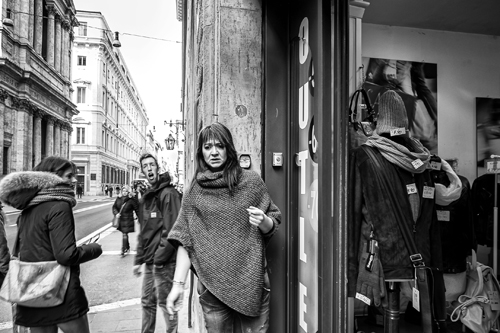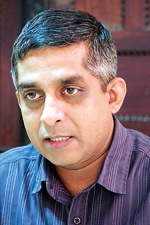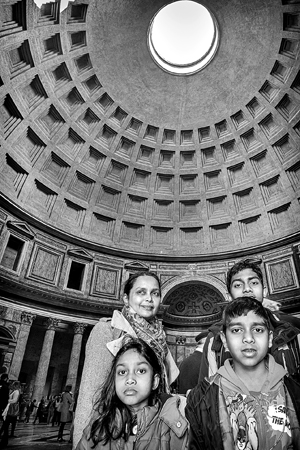Examining people through the lens

A favourite photograph of Dr. Udukala: “I didn’t even see the strange figure at the rear. It seems like an unexpected ‘gift’ thrown in.”
Wielding a stethoscope or peering into a microscope during his duty hours as a dedicated doctor, the minute he has leisure, it is the camera that he slings around his neck, for he feels that amidst the people he ‘captures’, he also finds himself.
Coming all the way from his home in Northampton, United Kingdom, to Sri Lanka to fulfil a self-made promise that he will hold a photography exhibition, before he turns 50 (on December 6), ‘Nimesha’ by Dr. Mangalanath Udukala is all about ‘People at Rest’.
Journeying not only along the main highways but also the byways and off the beaten track across Europe with his family of four, numerous are the photographs he has clicked, some in an instant but others after waiting and watching in expectation. He is however, only displaying 38 in all of which 28 are powerful black-and-white images, in this second exhibition after 24 long years. The first was in August 1995 when he was still a medical student.
“I feel that life is rushing past. The reality strikes me every time I see my eldest son’s empty bed, now that he is off to university,” says Dr. Udukala, a Consultant Microbiologist at King’s College Hospital in London, with a tinge of sadness in his voice.

Dr. Mangalanath Udukala
Dr. Udukala’s wife Anupama is a Consultant Histopathologist, while his eldest son, Venura (19) is studying biomedical sciences and his second son Ravija (15) and youngest daughter Devaki (13) are still in school. It is with them that he had toured Paris, Amsterdam, The Hague, Rome, Florence and even London, Edinburgh and Belfast on home-ground, sometimes flying and at others taking a bus or train but mostly walking to spots away from the touristy sites. A beautiful shot of the family, not ‘smiling cheese’ like most of us do, at the Pantheon in Rome, artfully done with a gap at the centre for him is the memento they have carried home.
It is on Wednesday morning that we meet him at the home of his brother Consultant Onco-surgeon Dr. Mahanada Udukala off the Thalapathpitiya Road, close to the Sri Jayewardenepura Hospital, for a chat which leads us into many un-thought of depths such as philosophy, humanity, art, expression and life itself.
…..And how simple moments, as we traverse the pathway of life, not attempting to stand out or collect trophies, add up to influence the bigger scheme of things.
From humble but solid stock, his father Udukalage Don Chandrapala, an ayurvedic physician, had been the first of their clan from the remote village of Udukala in the Kalutara district but very close to the Kalawana border, to venture out as a youth. Later along with his mother, Liyanage Alice Perera, a teacher, they had made their home in Nedimala, Dehiwela and it was here that they nurtured their two sons, Mahanada older by about 7½ years and Mangalanath.
Kalubowila Maha Vidyalaya, Mangalanath attended until Grade 5, moving to Nalanda College, Colombo thereafter.

Family at the Pantheon:Anupama, Venura, Ravija and Devaki
His parents never pushed him to achieve greatness. Mangalanath was above average in his studies and deemed intelligent but was never a star…..not at school, nor at the Faculty of Medicine, Colombo. “People kill the personality of a child by separating him from the others but I was allowed to find myself and my uniqueness and identify who I was by being among others,” he says.
He had been “hugely” influenced by his two maternal uncles – L. Wimalasiri Perera, the younger one, introducing Mangalanath to art at the tender age of 8, allowing him to draw at will, only guiding him with subtlety, without changing his visual expression. He recalls showing him a drawing of people and his uncle asking him whether they were still or moving. When told that they were still, he had suggested that Mangalanath try his hand at drawing people who were moving.
This was while his older uncle, L. Victor Perera, who was left-oriented and moved with stalwarts such as Bernard Soysa and Vivienne Gunawardene, took him to various places where there was much exposure to diversity and thus made him appreciate such diversity.
During his Advanced Level (AL) years, a casual suggestion by a friend led him to join the National Photographic Art Society founded by Wilson Hegoda.
Reiterating that small life events do not matter in the long run, he recalls how he did not get through the ALs the first shy as his thoughts were on the turbulent times in a country in the throes of an insurgency in 1988-89.
Dr. Udukala lists the milestones in his life which have guided him to where he is today – joining the National Photographic Art Society in 1989; entering Law College and getting an exposure to a distinctly different world from medicine in-between the two AL sittings; then changing direction and gaining admission to the Medical Faculty; getting a little recognition as the ‘photo-catcher’ of all events at the faculty; going to Hantane on the first trip of many as a first-year medico; falling in love with the girl who would become his wife; putting on display his photographic skills on the biththi-paththara of the faculty; holding the first-ever Arts Festival at the faculty; and being elected as the first Secretary of the Arts Society of the faculty, with Aruna Jayasekera as President.
Among the most poignant memories are of a Swedish friend of his father’s allowing him to use her SLR camera to take photos of children in a home on Pagoda Road, Nugegoda, whom she was hoping to support with funds. He had learnt the basics of photography but did not own a camera and so he “tried out a few things” as an amateur. A few months later, the friend returned and a memory etched forever……his father crossing their front garden with a small parcel – her gift of a camera to Mangalanath which “changed my life”.
Another is helping his younger uncle paint a bo-tree in a massive mural still covering a three-storey wall of the Sri Lanka Library Services Board, Colombo 7, which was being done by S.H. Sarath. “We studied bo-trees, how their branches evolved and how they were different to other trees. I helped to mix oil paint and learnt how to make lines thin or thick and also got a perspective on hue and volume,” he says.
Even though many have been his role models, both local and foreign, Dr. Udukala believes that his genre is in line with travel art photography or so-called street photography of the flaneur-kind which entails “wandering without purpose”.
French poet and art critic Charles Baudelaire gives a portrait of the flâneur as: “The crowd is his element……His passion and his profession are to become one flesh with the crowd. To be away from home and yet to feel oneself everywhere at home; to see the world, to be at the centre of the world and yet to remain hidden from the world…..Or we might liken him to a mirror as vast as the crowd itself; or to a kaleidoscope gifted with consciousness, responding to each one of its movements and reproducing the multiplicity of life and the flickering grace of all the elements of life.”
Looking at the photographic artistry of Dr. Udukala, Baudelaire’s description seems to fit the bill.
| The exhibition | |
| ‘Nimesha’, an Exhibition of Photographs on the theme ‘People at Rest’ by Dr. Mangalanath Udukala is on at the Harold Pieris Gallery of the Lionel Wendt Art Centre from 9 a.m. to 7 p.m. today and tomorrow.
|


